
Bearings manufacturer RBC Bearings (NYSE:RBC) reported Q2 CY2025 results exceeding the market’s revenue expectations, with sales up 7.3% year on year to $436 million. On top of that, next quarter’s revenue guidance ($450 million at the midpoint) was surprisingly good and 3.8% above what analysts were expecting. Its non-GAAP profit of $2.84 per share was 3.6% above analysts’ consensus estimates.
Is now the time to buy RBC Bearings? Find out by accessing our full research report, it’s free.
RBC Bearings (RBC) Q2 CY2025 Highlights:
- Revenue: $436 million vs analyst estimates of $432.4 million (7.3% year-on-year growth, 0.8% beat)
- Adjusted EPS: $2.84 vs analyst estimates of $2.74 (3.6% beat)
- Adjusted EBITDA: $141.5 million vs analyst estimates of $135 million (32.5% margin, 4.8% beat)
- Revenue Guidance for Q3 CY2025 is $450 million at the midpoint, above analyst estimates of $433.5 million
- Operating Margin: 23.2%, in line with the same quarter last year
- Free Cash Flow Margin: 23.9%, up from 21.8% in the same quarter last year
- Market Capitalization: $12.17 billion
“Our first quarter performance was solid with A&D and Industrial segment sales up 10.4% and 5.5%, respectively. Additionally, gross margin performance remained strong during the quarter due to our Industrial segment, highlighting the team’s hard work in driving synergies between Dodge and our broader Industrial business, combined with expansion in Aerospace,” said Dr. Michael J. Hartnett, Chairman and Chief Executive Officer.
Company Overview
With a Guinness World Record for engineering the largest spherical plain bearing, RBC Bearings (NYSE:RBC) is a manufacturer of bearings and related components for the aerospace & defense, industrial, and transportation industries.
Revenue Growth
A company’s long-term performance is an indicator of its overall quality. Any business can have short-term success, but a top-tier one grows for years. Luckily, RBC Bearings’s sales grew at an incredible 18.9% compounded annual growth rate over the last five years. Its growth beat the average industrials company and shows its offerings resonate with customers, a helpful starting point for our analysis.
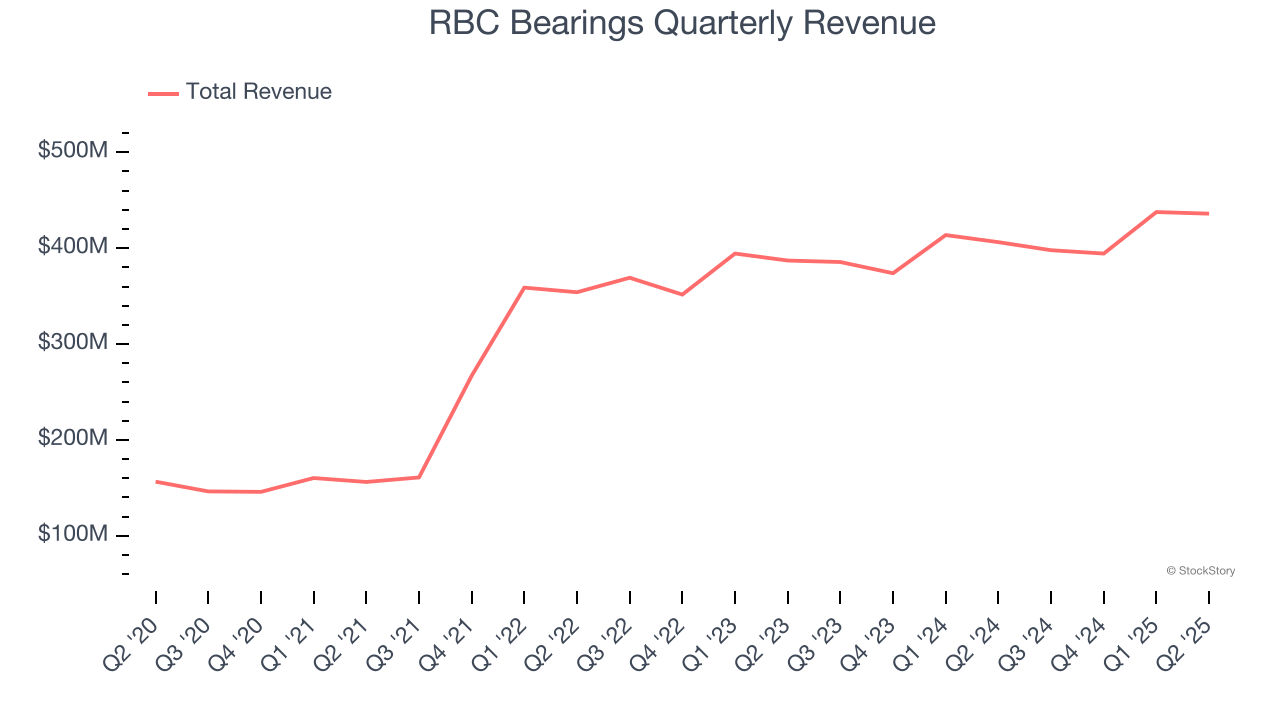
Long-term growth is the most important, but within industrials, a half-decade historical view may miss new industry trends or demand cycles. RBC Bearings’s recent performance shows its demand has slowed significantly as its annualized revenue growth of 5.3% over the last two years was well below its five-year trend. 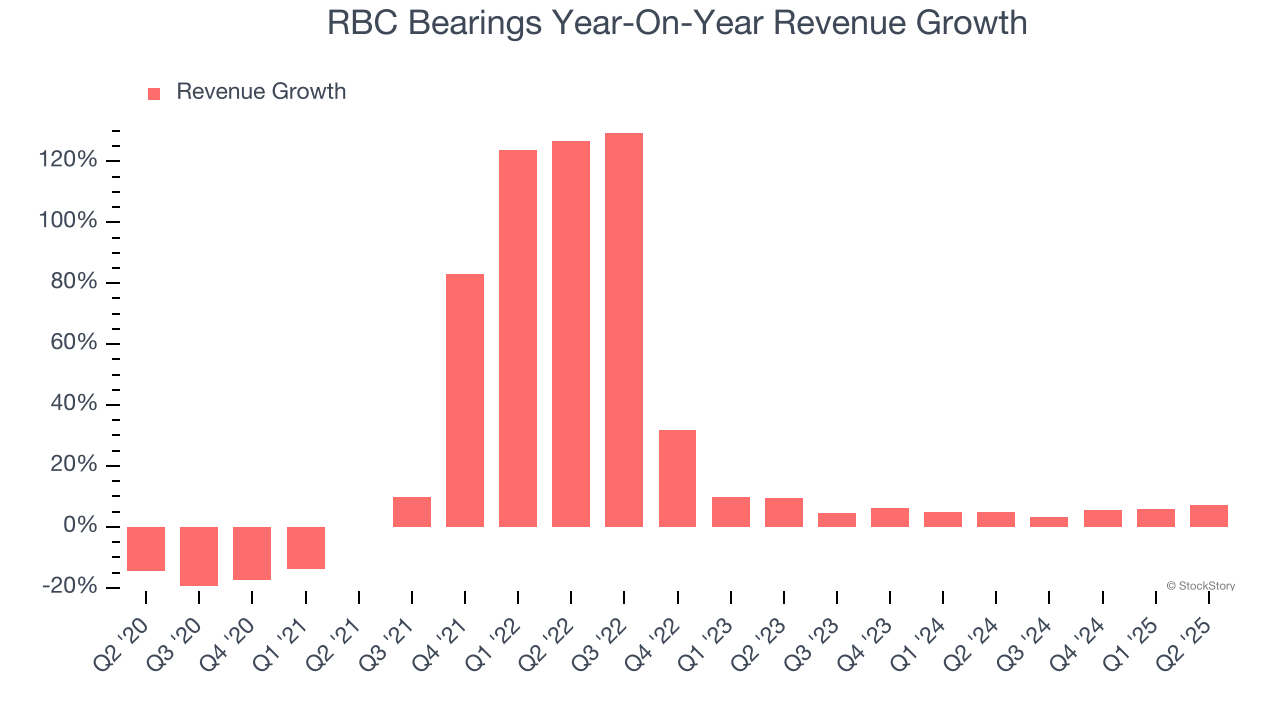
We can dig further into the company’s revenue dynamics by analyzing its most important segments, Diversified Industrials and Aerospace and Defense, which are 37.8% and 62.2% of revenue. Over the last two years, RBC Bearings’s Diversified Industrials revenue (general industrial equipment) averaged 4.8% year-on-year declines. On the other hand, its Aerospace and Defense revenue (aircraft equipment, radar, missiles) averaged 25.2% growth. 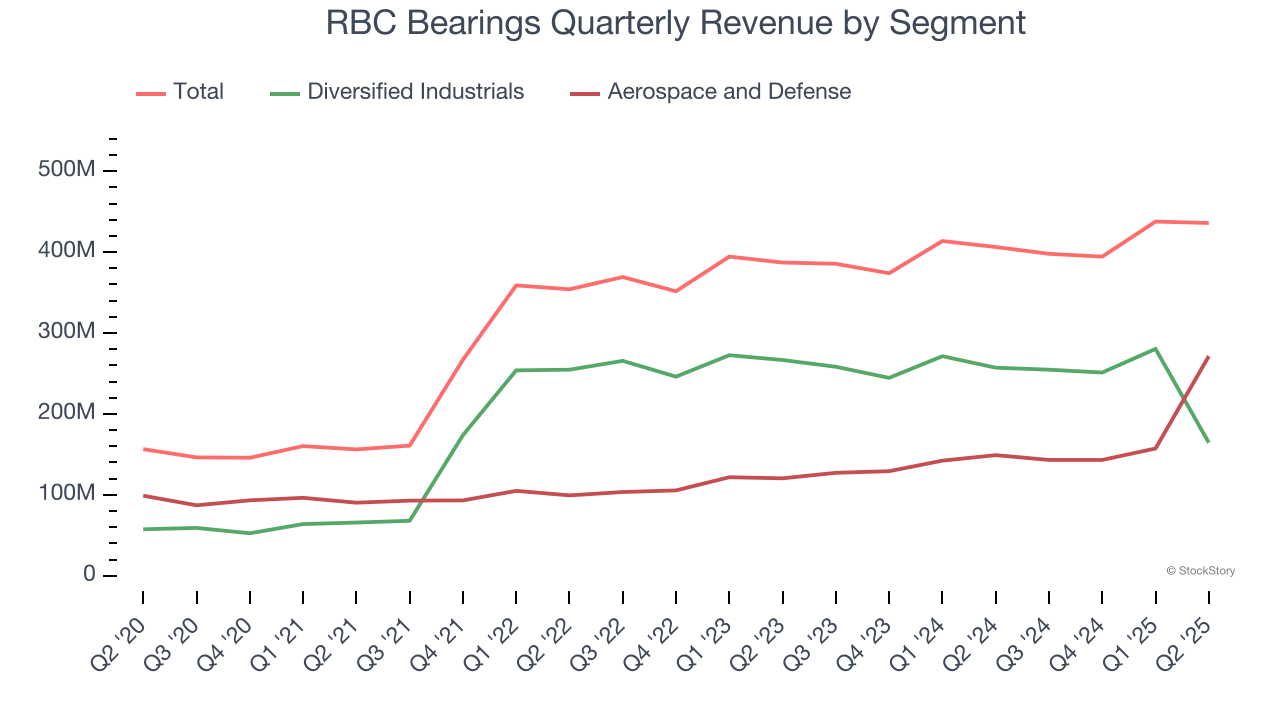
This quarter, RBC Bearings reported year-on-year revenue growth of 7.3%, and its $436 million of revenue exceeded Wall Street’s estimates by 0.8%. Company management is currently guiding for a 13.1% year-on-year increase in sales next quarter.
Looking further ahead, sell-side analysts expect revenue to grow 8.9% over the next 12 months, an improvement versus the last two years. This projection is above the sector average and suggests its newer products and services will fuel better top-line performance.
Unless you’ve been living under a rock, it should be obvious by now that generative AI is going to have a huge impact on how large corporations do business. While Nvidia and AMD are trading close to all-time highs, we prefer a lesser-known (but still profitable) stock benefiting from the rise of AI. Click here to access our free report one of our favorites growth stories.
Operating Margin
Operating margin is an important measure of profitability as it shows the portion of revenue left after accounting for all core expenses – everything from the cost of goods sold to advertising and wages. It’s also useful for comparing profitability across companies with different levels of debt and tax rates because it excludes interest and taxes.
RBC Bearings has been a well-oiled machine over the last five years. It demonstrated elite profitability for an industrials business, boasting an average operating margin of 20.2%. This result isn’t surprising as its high gross margin gives it a favorable starting point.
Analyzing the trend in its profitability, RBC Bearings’s operating margin rose by 4 percentage points over the last five years, as its sales growth gave it operating leverage.

In Q2, RBC Bearings generated an operating margin profit margin of 23.2%, in line with the same quarter last year. This indicates the company’s cost structure has recently been stable.
Earnings Per Share
We track the long-term change in earnings per share (EPS) for the same reason as long-term revenue growth. Compared to revenue, however, EPS highlights whether a company’s growth is profitable.
RBC Bearings’s EPS grew at a spectacular 16.5% compounded annual growth rate over the last five years. Despite its operating margin improvement during that time, this performance was lower than its 18.9% annualized revenue growth, telling us that non-fundamental factors such as interest and taxes affected its ultimate earnings.
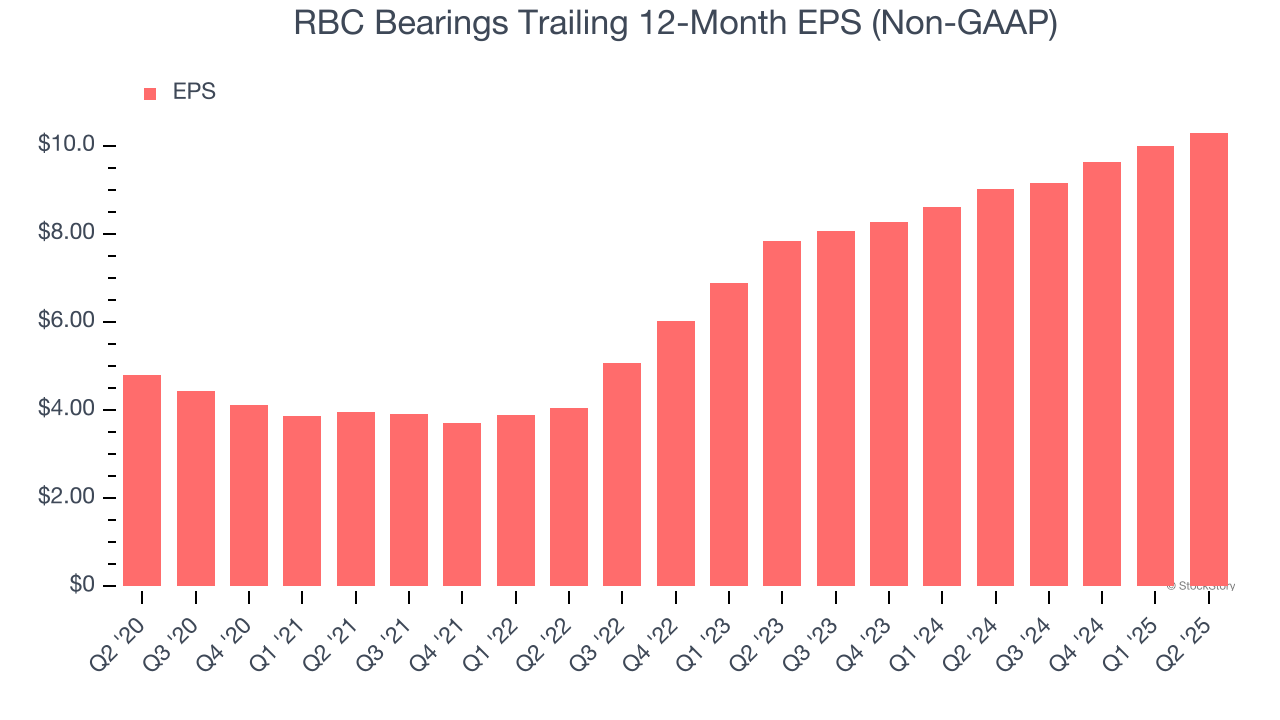
We can take a deeper look into RBC Bearings’s earnings quality to better understand the drivers of its performance. A five-year view shows RBC Bearings has diluted its shareholders, growing its share count by 26.5%. This dilution overshadowed its increased operating efficiency and has led to lower per share earnings. Taxes and interest expenses can also affect EPS but don’t tell us as much about a company’s fundamentals. 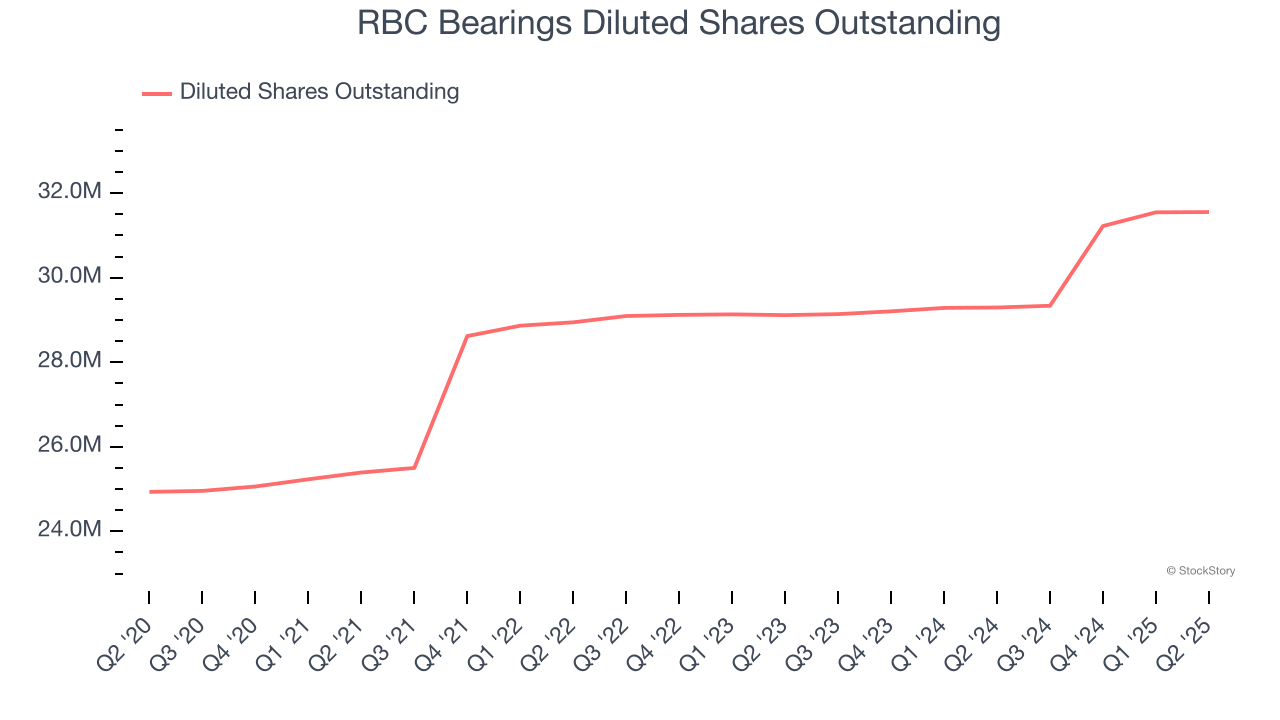
Like with revenue, we analyze EPS over a more recent period because it can provide insight into an emerging theme or development for the business.
For RBC Bearings, its two-year annual EPS growth of 14.7% was lower than its five-year trend. We still think its growth was good and hope it can accelerate in the future.
In Q2, RBC Bearings reported adjusted EPS at $2.84, up from $2.54 in the same quarter last year. This print beat analysts’ estimates by 3.6%. Over the next 12 months, Wall Street expects RBC Bearings’s full-year EPS of $10.30 to grow 15.1%.
Key Takeaways from RBC Bearings’s Q2 Results
We enjoyed seeing RBC Bearings beat analysts’ EBITDA expectations this quarter. We were also glad its revenue guidance for next quarter exceeded Wall Street’s estimates. Overall, we think this was a solid quarter with some key areas of upside. The stock traded up 1.3% to $392 immediately after reporting.
RBC Bearings put up rock-solid earnings, but one quarter doesn’t necessarily make the stock a buy. Let’s see if this is a good investment. What happened in the latest quarter matters, but not as much as longer-term business quality and valuation, when deciding whether to invest in this stock. We cover that in our actionable full research report which you can read here, it’s free.
